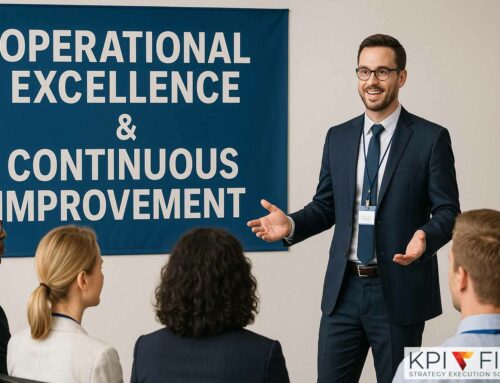The best Operational Excellence examples can be found in the realm of the pursuit of perfection in every aspect of an organization’s operations. It’s about streamlining processes, reducing waste, and maximizing efficiency to achieve superior performance and customer satisfaction. By embracing operational excellence, businesses can gain a competitive edge, increase profitability, and build lasting customer relationships. In this blog post, we’ll explore 12 key examples of operational excellence successes and provide practical tips to help you implement these strategies in your own organization.
What Is Operational Excellence?
Operational excellence is a philosophy and set of practices focused on continuous improvement and efficiency across all aspects of an organization. It aims to optimize processes, reduce waste, and deliver exceptional value to customers while enhancing overall business performance.
Key Frameworks for Achieving Operational Excellence
To achieve operational excellence, organizations often leverage proven frameworks and methodologies. These frameworks provide a structured approach to identify areas for improvement, implement changes, and measure results.
Lean Management
Lean management is a methodology focused on eliminating waste and maximizing value. It involves identifying and eliminating non-value-added activities within a process, streamlining workflows, and continuously improving efficiency. By focusing on customer value and reducing waste, organizations can achieve significant cost savings, improve quality, and increase customer satisfaction.
Six Sigma
Six Sigma is a data-driven methodology aimed at reducing defects and improving process capability. It employs a structured approach, including Define, Measure, Analyze, Improve, and Control (DMAIC), to identify and eliminate root causes of variation. By setting ambitious quality goals and using statistical tools, organizations can achieve significant process improvements and enhance customer satisfaction.
Kaizen
A Japanese philosophy, emphasizes continuous improvement through small, incremental changes. It involves all employees in identifying and implementing improvements to processes, eliminating waste, and increasing efficiency. By fostering a culture of innovation and problem-solving, Kaizen can lead to significant long-term benefits for organizations.
Total Quality Management (TQM)
Total Quality Management (TQM) is a comprehensive approach to quality improvement that involves all members of an organization. It emphasizes customer satisfaction, continuous improvement, and employee empowerment. By focusing on preventing defects, reducing waste, and enhancing process efficiency, TQM helps organizations achieve long-term success.
Balanced Scorecard (BSC)
Hoshin Kanri, or Policy Deployment, is a strategic planning and management system that aligns an organization’s goals and objectives. It involves cascading goals from the top level of management to lower levels, creating a shared vision and ensuring that everyone is working towards the same objectives. By focusing on strategic priorities and measuring progress, Hoshin Kanri helps organizations achieve their long-term goals.
Agile
Agile is an iterative approach to project management, particularly in software development. It emphasizes flexibility, collaboration, and customer satisfaction. Agile methodologies, such as Scrum and Kanban, break down projects into smaller, manageable iterations called sprints. By delivering working software frequently and adapting to changing requirements, Agile teams can respond quickly to market changes and deliver high-quality products.
Hoshin Kanri (Policy Deployment)
Hoshin Kanri, or Policy Deployment, is a strategic planning and management system that aligns an organization’s goals and objectives. It involves cascading goals from the top level of management to lower levels, creating a shared vision and ensuring that everyone is working towards the same objectives. By focusing on strategic priorities and measuring progress, Hoshin Kanri helps organizations achieve their long-term goals.
Continuously Improve With Our Latest News & Updates
12 Operational Excellence Examples and Success
Operational excellence is not just a theory; it’s a reality that can be achieved through practical implementation. Here are 12 real-world examples of operational excellence and the strategies that led to their success.
From Hurricane Katrina to New-found Success
After Hurricane Katrina devastated Louisiana, Ruth Kennedy, director of Medicaid and Children’s Health Insurance Program eligibility for the Louisiana Department of Health and Hospitals, saw an opportunity to transform the state’s healthcare eligibility process. Rather than simply rebuilding, Kennedy wanted to create an improved system.
By leveraging Lean Six Sigma to implement a disciplined, team-based approach, the state not only rebuilt but optimized government operations to be more effective. This transformation is an inspiring example of how adversity can drive innovation and efficiency.
Walmart Saved $30M With One Simple Idea
CEO Doug McMillon said, at the retailer’s annual shareholders meeting in Bentonville, Arkansas, that Walmart will save at least $30 million this year by swapping out existing stepping stools in its distribution centers with a lighter-weight version. Read more here.
Proactive Manager Delivers Over $1M in 3 Year Implementation Period
This initiative by Russ Westcott produced a documented net payoff of more than $1 million over the three-year implementation period. In that time, 72 projects were implemented, with ROIs ranging from 5-to-1 to 400-to-1, and launched a new career. Be sure to read up on the rest of the success story here.
Philips Lighting Shows How Six Sigma Can Benefit Your Organization
Through the application of multiple tools and techniques within the Project Management, Lean, and Six Sigma methodologies within its project initiative, this example shows how Philips Lighting achieved consistent delivery reliability, pulled customer lead-times from 1% to 42%, and replicated these improvements across 50% of the Outdoor NA portfolio.
North American Building Materials Manufacturer Generates $15M In Savings Through Continuous Improvement Program. Find out how Philips Lighting managed to achieve such success by reading the whole story.
Commercial Banking Improved Processes and Cut Back Office Costs by 30%
This team took insights from the past 5 years to inform their decisions for Continuous Improvement. You can gain inpiration and ignite your own success story by learning from Commercial Banking’s full success story.
Black & Veatch Earns Excellence Award for Oil & Gas, Power & Utilities
This business excellence program started with 20 people and within 10 years had 2000 active participants, resulting in an 8x increase in tangible, validated benefits for the company and partners or over $100M annually on 3B in Revenue (3%). Read more here.
NextEra Energy (NEE) Promotes Six Sigma Certification
In 4 years, over 5,000* NEE employees obtained Lean Six Sigma (LSS) certifications and their Quality projects have generated over $500M in net present value savings for the company (not counting the Yellow Belt “quick win” improvements that are not tracked). Almost 25% of their Senior Leaders are Lean Six Sigma certified*, including the KPI Fire CEO! Read more of this story here.
Johnson Controls Unlocks Record-Breaking Success Through Six Sigma Principles
300 plants, 120,000 employees. 100% of 400 of Full Time Continuous Improvement professionals were trained. 16,501 projects initiated, 99.9% of projects were completed. Read the whole inspiring story here.
GKN Aerospace Embraces Lean Leadership
This piece on OpEx successes wouldn’t be complete without a story by GKN Aerospace. As an expert on Lean transformation, Philip Holt has more than one success story to share. After twelve years at Philips, being based in the Netherlands, he took his present position at GKN Aerospace as Senior Vice President of Operational Excellence. Philip shares how he managed to transform both Philips and GKN by and through his winning methodologies on “Leading with Lean”. Read more here.
European Bank Applies Six Sigma Methodologies
A European investment bank sought to enhance its cash payment procedures with the goal of minimizing errors and delays, ultimately aiming to enhance customer satisfaction.
To achieve this, the bank applied lean Six Sigma methodologies to identify instances of rework and eliminate unnecessary and duplicated tasks, optimizing the flow of activities from its front offices to operations and back offices. Read more, here.
Glaxo Smith Kline Incorporates ADP
GlaxoSmithKline (GSK) observed that while Lean Six Sigma, project management, and organizational development were delivering measurable improvements in various divisions, none of these methodologies alone could fully support the company’s strategic goals.
GSK hypothesized that integrating all three disciplines—termed ADP—would create a more comprehensive and impactful approach to operational excellence. The combined application of these methods has fostered greater engagement, efficiency, and long-term success.
Raymond Corporation Celebrates Milestone in Kaizen Program
The Raymond Corporation recently celebrated a milestone in its Kaizen program, with over 150,000 employee suggestions submitted. This philosophy of continuous, incremental improvement has driven significant advancements in efficiency, cost reduction, and customer satisfaction.
By fostering a culture of innovation and actively supporting employee engagement through training and recognition, Raymond has positioned itself as a leader in operational excellence and continues to deliver exceptional value to its customers.
How to Achieve Operational Excellence in Your Business
To achieve operational excellence, organizations must adopt a comprehensive approach that involves strategic planning, process improvement, and a strong focus on continuous improvement. Here are key steps to help you embark on this journey:
1. Integrate Key Frameworks
Incorporate relevant frameworks like Lean, Six Sigma, and Kaizen into your operations. These frameworks provide structured methodologies for identifying and eliminating waste, improving quality, and enhancing efficiency.
2. Align with Business Strategy
Ensure that your operational excellence initiatives are aligned with your overall business strategy. This means focusing on the activities that directly contribute to your organization’s goals and objectives.
3. Foster a Culture of Continuous Improvement
Create a culture where improvement is a continuous process. Encourage employees to identify opportunities for improvement, share ideas, and participate in problem-solving initiatives.
4. Track Against Key Performance Indicators (KPIs)
Establish key performance indicators to measure the effectiveness of your operational excellence initiatives. Regularly monitor these KPIs to identify areas for improvement and celebrate successes.
5. Enhance Cross-Functional Collaboration
Break down silos and encourage collaboration between different departments. By working together, teams can identify and address issues more effectively and implement improvements more efficiently.
6. Invest in Training and Development
Provide employees with the necessary training and development opportunities to acquire the skills and knowledge needed to drive operational excellence.
7. Standardize and Scale Business Processes
Develop and implement standardized processes to ensure consistency and efficiency. Once processes are standardized, identify opportunities to scale them across the organization.
8. Monitor, Review, and Adapt
Continuously monitor your operational performance, review your progress, and adapt your strategies as needed. This iterative approach will help you stay ahead of the curve and achieve sustained excellence.
Boost Operational Efficiency with KPI Fire
Operational excellence frameworks like Lean, Six Sigma, Kaizen, TQM, Hoshin Kanri, and Agile provide structured approaches to improve processes and drive business performance. By eliminating waste, reducing defects, and focusing on customer value, these frameworks help organizations achieve significant cost savings, enhance quality, and increase customer satisfaction
KPI Fire’s Operational Excellence Software and solutions are designed to align with these operational excellence best practices and empower organizations to achieve superior performance. Here’s how KPI Fire supports these strategies:
- Streamlining Operations: KPI Fire’s platform enables organizations to centralize data, automate processes, and eliminate manual tasks, streamlining workflows and reducing operational costs.
- Tracking Key Metrics: KPI Fire provides a comprehensive suite of tools to track and monitor key performance indicators (KPIs), allowing organizations to measure progress, identify bottlenecks, and make data-driven decisions.
- Fostering a Culture of Continuous Improvement: KPI Fire’s collaborative features and real-time insights encourage a culture of continuous improvement by empowering employees to identify opportunities, propose solutions, and track the impact of their initiatives.
- Aligning with Business Strategy: KPI Fire’s strategic planning tools help organizations align their operational goals with their overall business strategy, ensuring that every action contributes to the achievement of long-term objectives.
- Data-Driven Decision Making: KPI Fire’s data-driven approach enables organizations to make informed decisions based on real-time insights and historical trends. By leveraging data analytics, organizations can identify opportunities for improvement, optimize resource allocation, and mitigate risks.
By utilizing KPI Fire’s tools and solutions, organizations can effectively implement operational excellence frameworks, drive performance improvements, and achieve sustainable success.





